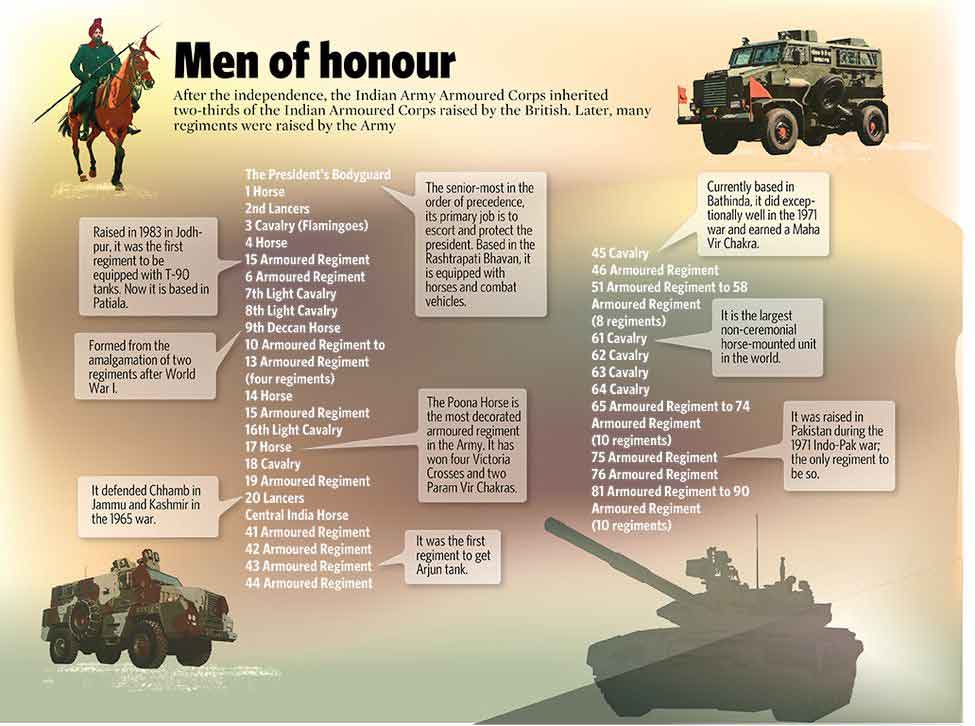Ahmednagar, the western Maharashtra district of prosperous sugarcane farmers, lives in the shadow of history. It was here that Ahmednagar Sultans laid the foundation of their kingdom. It was here that Chand Bibi challenged the might of Emperor Akbar. It was here that Maratha armies crushed Nizam's forces to begin the northward expansion of their kingdom. Little wonder then that two of Indian Army's elite training establishments—Armoured Corps Centre and School and Mechanised Infantry Regimental Centre—are based in Ahmednagar.
Armoured corps is considered modern-day cavalry. If cavalries brought speed and mobility to the battlefields of yore, tanks play the role in today's battles. The Indian Army's 3,000 plus tanks are divided among some 60 armoured regiments; each one with about 50 tanks and other vehicles. The regiments are divided in three sabre squadrons and one headquarters squadron. Each of these sabre squadrons—Alpha, Bravo and Charlie—is equipped with 14 tanks. The headquarters squadron is an administrative unit and has three tanks, including that of the commandant who is an officer of the rank of colonel.
The squadron is further divided into troops, each of which has three tanks and is normally commanded by a young officer. And, finally, each tank is commanded by a senior non-commissioned officer or a junior commissioned officer.
Armoured Corps Centre and School (ACC&S) was established in 1924. The British called it Royal Tank Corps School. When a recruit joins the Army and is selected for armoured corps, he comes to Ahmednagar for training at ACC&S. Similarly, a newly commissioned armoured corps officer comes to Ahmednagar for Young Officers' course, which lasts six months and imparts intensive training in all aspects of tanks and tank warfare.
“When I went to the National Defence Academy as a young cadet, we had 3-4 officers from armoured corps on the staff,” says Major General (retired) Rajan Aney, a veteran of the armoured corps. “They were young captains and majors, all flamboyant and dashing. I am not saying that the other officers didn't possess all these, but there was something about these officers that made them stand ahead of others. For a cadet this is a fascinating aspect.”
When Aney moved to the Indian Military Academy, he was part of a platoon commanded by Captain Sudhir Kumar Sonpar, an armoured corps officer who had won a Vir Chakra during the peacekeeping operations in Congo. “Personalities of these officers influenced me when I was commissioned in 63 Cavalry regiment,” says Aney, who retired in 2002 as additional director general for combat vehicles.
Once commissioned, armoured corps officers spend 3-4 months with their regiments, and then go to Ahmednagar ACC&S for the Young Officers' course. In this course, they are taught military history, tank driving, maintenance, gunnery, and communications training in tactics and manoeuvres among other things. “We were not considered as officers till we had completed our YO's course. We were addressed as mister so and so, though we had been commissioned, as we knew nothing about tanks and tank warfare. It was only after completing the YO's course and passing retention examination that everyone used to treat us as armoured corps officers,” says Aney.
 Graphics: N.V. Jose
Graphics: N.V. Jose
The rapid expansion of the Army's armoured corps started soon after the 1965 war with Pakistan. “It was a war of mobile warfare and tank battles,” says Aney. “This was also the war in which we realised that Pakistan is potentially our number one enemy. After the war it was felt that we were woefully short of equipment and tanks. So, 1966 onwards there was rapid expansion of armoured corps.” During this expansion Aney was pulled out of 63 Cavalry and posted to 65 Armoured Regiment. He eventually commanded the regiment.
ACC&S plays an important role in preparing the tank men. “The entire training of the armoured corps is imparted here,” says Major General Pravin Dixit, commandant of ACC&S. “Training of recruits is done at Armoured Corps Centre, and advanced training, both technical and tactical, is done at the School; that is why it is called Armoured Corps Centre and School.”
Then the officers come back for an advanced course. “The training of young officers is divided into four phases encompassing driving and maintenance, gunnery, communications and IT, culminating in the tactical phase. The officers are also exposed to latest trends in technology. During the tactical phase, due emphasis is laid on aspects such as development of leadership qualities, logistics planning, maintenance of morale, team building and cohesion,” says Lt-Gen (retired) Anil Malik, former commandant of Armoured Corps Centre and School.
Then comes the time to apply these skills in the battlefield scenario. “How to manoeuvre tanks to successfully overpower the enemy on a battlefield is taught at School of Armoured Warfare. We teach tactics, the application of all your technical knowledge to destroy the enemy. They learn during armament phase that aim of a tank is to destroy another tank of at least equal weight and classification, but it is not easy. It is not just gunnery skill because the other guy also has a gun. So how do you manoeuvre yourself to come at a place of advantage using terrain and other forces, get onto his flanks of weakness and destroy him? This is what is taught at Armoured Warfare School,” says Brigadier Akash Bhanot, head of Armoured Warfare School at ACC&S.
On January 6, ACC&S and Mechanised Infantry Regiment Centre conducted an Integrated Fire Power and Manoeuvre Exercise. Two pioneers who revolutionised tank warfare—British major general J.F.C. Fuller and the German general Heinz Guderian—were remembered at the event. “It was Fuller's idea to introduce black dungaree and black berets as Royal Tank Corps' uniform as he felt that stains of oil and grease on the uniforms of tank men cannot be spotted,” said a commentator at the event. Similarly, when the Line of March Attack was in progress, the commentator used a famous quote by Guderian: “The engine of the Panzer is as much its weapon as its gun.”
According to Dixit, Guderian's operations and his writings are crucial part of learning. “Ask any tank man at any level, readings about Guderian and his works are his bible,” he says. Adds Bhanot: “Guderian is the most respected tank warfare theorist. Whatever they taught that time—fire and move, fire and manoeuvre—is as relevant today as it was back then.” Commissioned in 67 Armoured Regiment, Bhanot calls himself a proud cavalier. In fact, it runs in his family: his great-grandfather was in the cavalry of the Maharaja of Patiala. Later, Bhanot commanded 89 Armoured Regiment.
The bonding between the men and their tanks is reflected in the interesting names given to their machines. The tank commanded by the legendary Lt-Col Ardeshir Tarapore, who was awarded Param Vir Chakra for his bravery in the 1965 war, was called Kooshab. “We are nothing without our equipment. Tank is a fighting member of our unit and hence he should also have a name,” says Bhanot. “That is the sentiment behind naming tanks. My tank when I got commissioned was named Azad. When I came back from advanced course where I did well my tank was named Akash. So we had two Akashs in our unit; my tank and me.”
Malik says tank crews do not consider their mount as a war machine. “The crew of the tank consider themselves an integral part of the weapon platform. The idea of having a name stems from identification as a whole. The name may take any form, be it an event in the history of the regiment, a place where lineage was drawn from or a special characteristic. In my regiment tanks from Alpha squadron had names starting with A, Bravo squadron with B and Charlie squadron with C. Tanks of regimental headquarters had names starting with R. My tank as a commanding officer was named 'Rajpramukh',” he says.
In armoured corps, three squadrons of a regiment used to be recruited from specific races or communities (fixed class regiment). For instance, Squadron A would be all Sikhs, Squadron B would be Jats, and Squadron C would be Rajputs. The first regiment to recruit from mixed classes was 66 Cavalry which was raised in 1966. “All the new regiments are mixed class while the older ones continue to have fixed class,” says Bhanot.
Col (retired) Virendra Swaroop, who wrote the engaging book Across Seven Seas: The Memoir Of A War Veteran, served in the famed Poona Horse armoured regiment in the 1965 and 1971 wars against Pakistan. This regiment, which was called Fakhr-i-Hind (pride of India) by the Pakistanis, has won five Victoria Crosses, two Param Vir Chakras (Lt-Col Tarapore in 1965 war and Lt Arun Khetrapal in 1971), three Maha Vir Chakras and many other honours. In his book, Swarup writes about the interesting tradition called 'dining in' that a young officer joining the regiment has to undergo. It is a custom in which all new officers are dined in formally. Colonel Swarup was shown paintings of every hero of the regiment and made to drink a peg every time.
General Aney's memories of his own dining in are still vivid. “The officers who were a little more senior were the ones who plied me with drinks and made me do some funny pranks, all in good humour. It was not ragging at all,” he says.
The fascination of armoured corps runs in many families, with several generations serving in it. “My grandfather and father served in Poona Horse. I am now serving in 1 Horse,” says Pramod Kumar, a daffadar.
And, there are others like Lt-Col Digvijay Singh Chauhan, who broke away from the tradition of serving in the infantry to join armoured corps. Chauhan was fascinated by tanks and affectionately calls them monsters. “Monster because of the shock and the effect that it has on enemy psyche,” he says. “It is a great war machine.”







